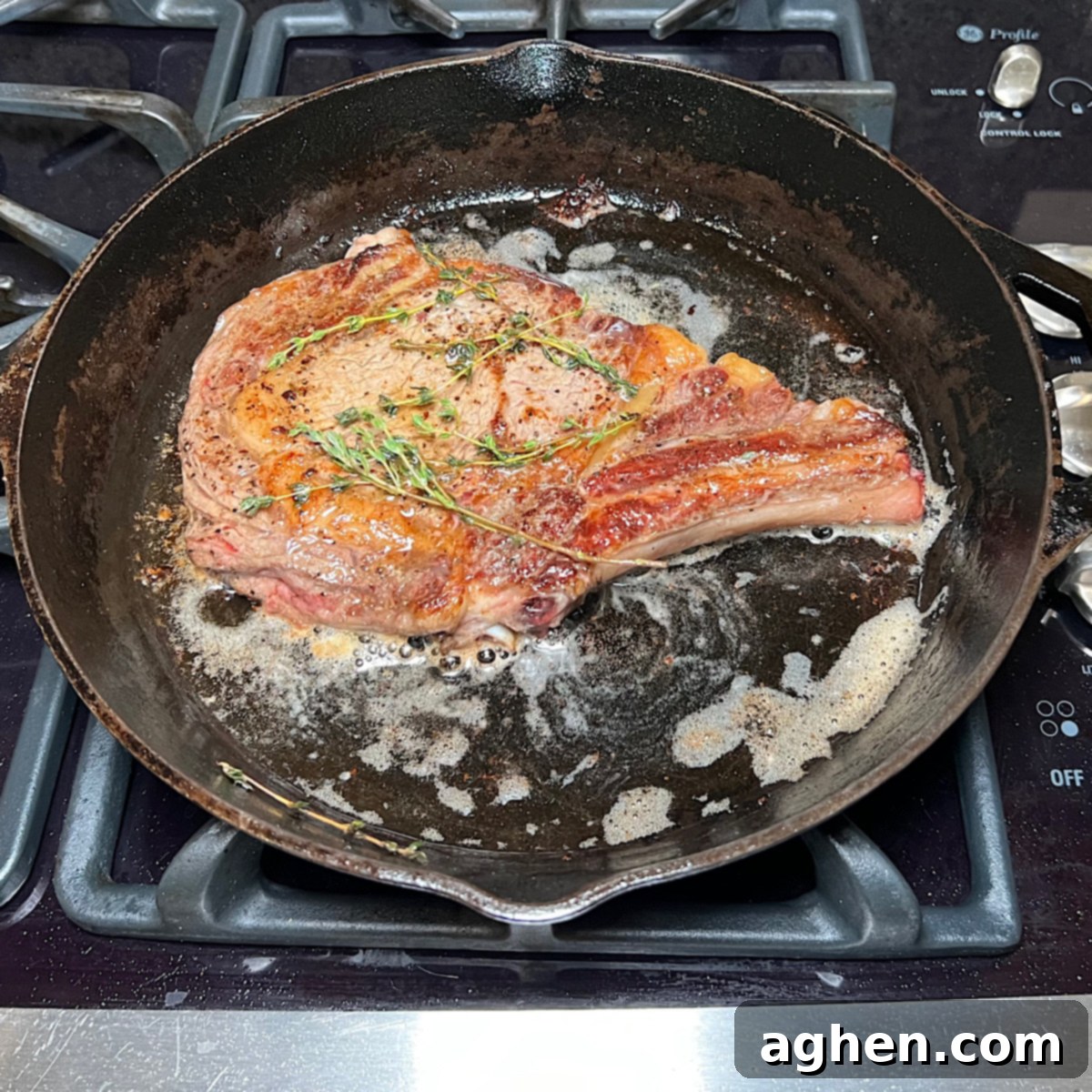Perfect Cast Iron Skillet Ribeye Steak: Master the Sear with Creamy Mustard Sauce
There’s nothing quite like the sizzle and aroma of a perfectly cooked steak. While many methods exist, few compare to the unparalleled crust and juicy interior achieved when cooking a ribeye in a cast iron skillet. This timeless technique transforms a simple cut of meat into a restaurant-quality meal right in your own kitchen. Forget fancy grills or complex preparations – with just a few essential ingredients and the right approach, you can master the art of cast iron steak.
In this comprehensive guide, we’ll walk you through every step, ensuring you create a mouthwatering ribeye with that coveted deep, savory sear. We’ll also include a delightful, optional mustard cream sauce recipe, cooked directly in the same skillet, to elevate your steak experience even further. Get ready to impress your taste buds and hone your culinary skills!
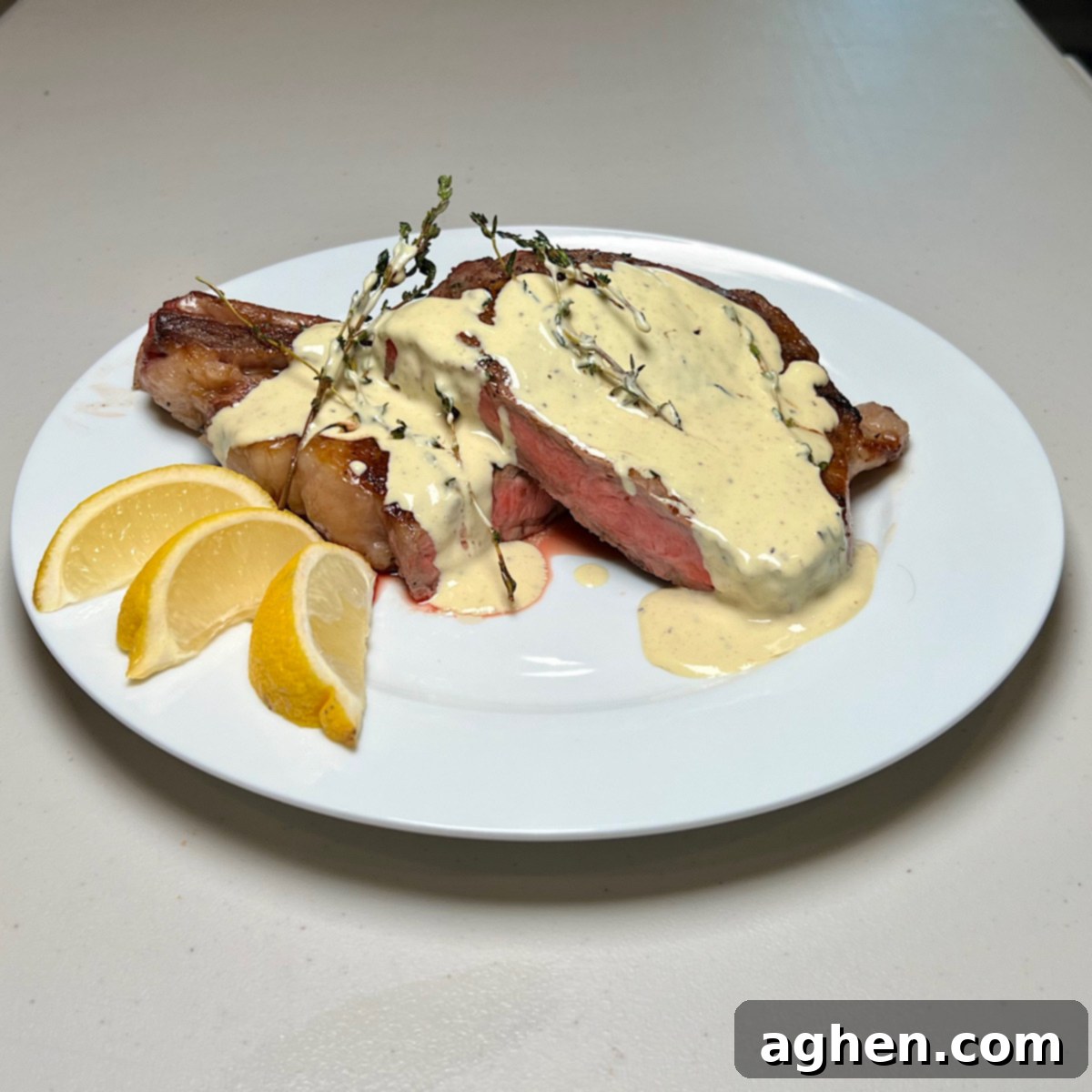
Why You Should Master Ribeye Steak in a Cast Iron Skillet
Discover the compelling reasons why cooking ribeye steak in a cast iron skillet is a superior method, promising incredible flavor, efficiency, and a rewarding culinary experience:
- Achieve an Incredible, Deep Crust: The cast iron skillet is truly a game-changer when it comes to steak. Its exceptional heat retention allows it to reach incredibly high temperatures, creating the ideal conditions for the Maillard reaction. This chemical process is responsible for the rich, complex flavors and the beautiful, deep brown crust that develops on the surface of your ribeye. When your steak hits that smoking hot cast iron, you’re not just cooking it; you’re creating a flavor masterpiece. The intense, direct heat ensures a uniform, crispy exterior, while locking in all the natural juices, guaranteeing a supremely succulent and beefy interior.
- Remarkably Quick Cooking Time: One of the many advantages of using a cast iron skillet for your ribeye is the speed at which it cooks. By utilizing very high temperatures, the cooking time for even a thick cut of steak is dramatically reduced. This means less waiting and more enjoying that incredible meaty flavor. High-heat searing also helps to minimize moisture loss, contributing to a tender steak that’s cooked quickly and efficiently, perfect for busy weeknights or when you’re craving a gourmet meal without the long wait.
- A Fun and Rewarding Culinary Skill: Beyond the delicious results, mastering the art of cooking with a cast iron skillet is an incredibly rewarding experience. While there might be a slight learning curve initially, the techniques are straightforward and easily perfected with a few practice sessions. Once you understand how to properly heat, sear, and maintain your cast iron, your overall culinary skills will see a significant boost. There’s an immense sense of accomplishment that comes with perfectly executing a dish using this classic cookware, making you feel like a seasoned chef in your own kitchen. It’s not just cooking; it’s an enjoyable journey into traditional, effective culinary methods that yield consistently amazing results.
- Elevate Your Meal with an Optional Mustard Cream Sauce: To take your ribeye steak to an even higher level of gourmet delight, we’ve included a recipe for an exquisite mustard cream sauce. This bonus recipe is designed to be prepared directly in your cast iron skillet after the steak has finished cooking and is resting. The sauce utilizes the flavorful fond left in the pan, incorporating heavy cream and Dijon mustard to create a rich, tangy, and incredibly smooth accompaniment. While your perfectly cooked ribeye is fantastic on its own, this creamy, savory sauce adds a sophisticated depth of flavor that complements the beef beautifully, transforming a great meal into an extraordinary dining experience.
- Versatility and Longevity: Cast iron skillets are incredibly versatile and durable. Once you learn to sear a steak, you’ve unlocked the potential for countless other dishes, from pan-seared chicken to roasted vegetables and even desserts. A well-cared-for cast iron pan can last for generations, becoming a cherished piece of cookware that only gets better with age and use. It’s an investment that pays off with every delicious, home-cooked meal.
Essential Ingredients for a Cast Iron Ribeye Steak
Gather these simple ingredients to create your masterpiece:
- One Ribeye Steak: Approximately 1 ½ to 2 pounds and 1 ½ inches thick for ideal searing.
- Salt and Pepper: About ½ teaspoon each, or to taste, for generous seasoning.
- Olive Oil: ¼ cup, for pre-seasoning the skillet and initial searing.
- Fresh Thyme: 6 sprigs, for aromatic basting.
- Unsalted Butter: 3 tablespoons, softened to room temperature for basting and flavor.
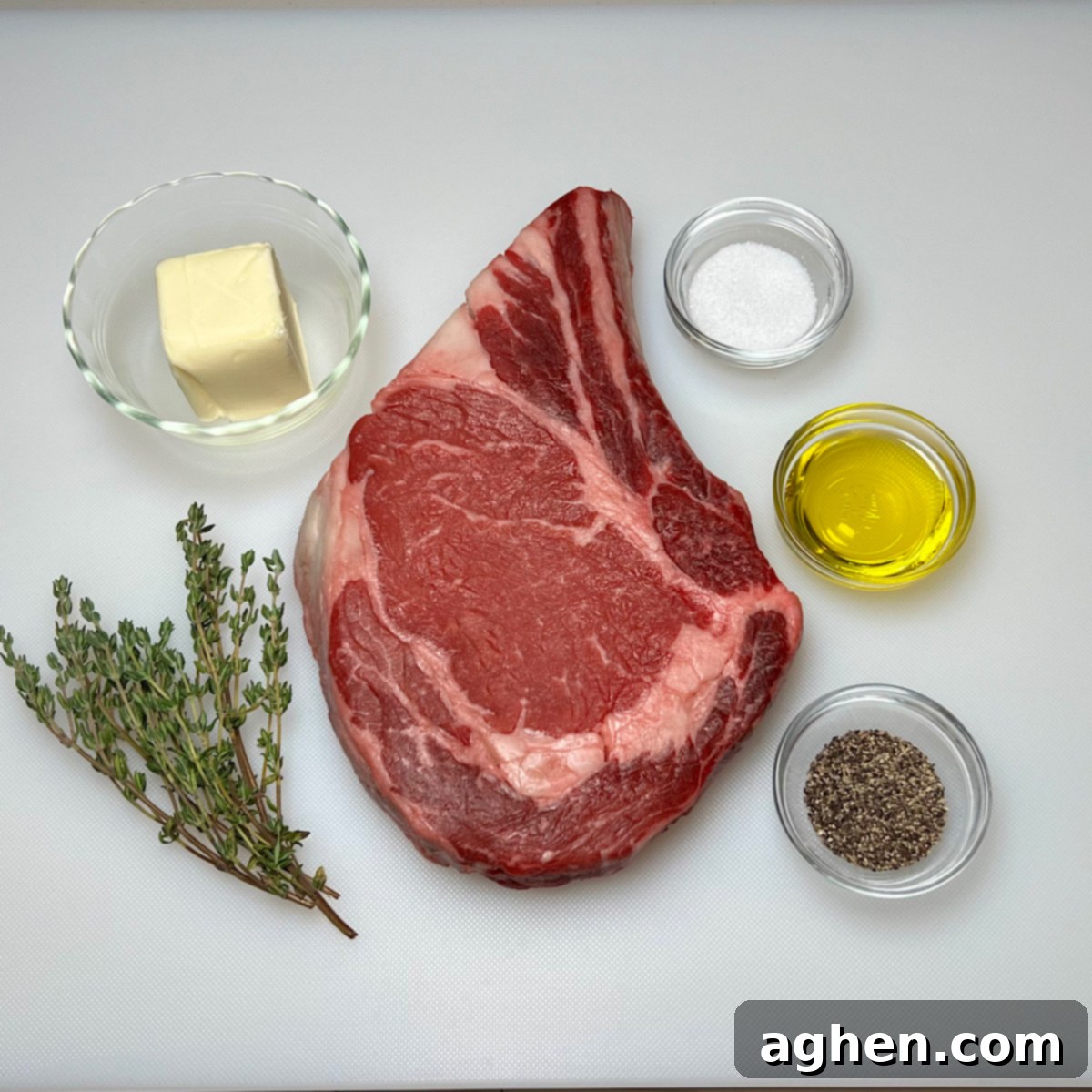
Ingredients for the Optional Mustard Cream Sauce
To enhance your steak with a rich sauce, you’ll need:
- Heavy Cream: ¾ cup, for a luscious, creamy base.
- Dijon Mustard: 3 tablespoons, to add a tangy, complex flavor.
- Salt and Pepper: A pinch of each, to season the sauce to perfection.

Step-by-Step Directions for a Perfect Cast Iron Ribeye Steak
Follow these detailed instructions to achieve an impeccable sear and juicy interior:
1. Prepare the Ribeye Steak: Remove your ribeye steak from the refrigerator at least 15-20 minutes before you plan to cook it, allowing it to come closer to room temperature. This crucial step ensures more even cooking throughout the steak, preventing the outside from overcooking while the inside remains cold. During this resting period, pat the steak thoroughly dry with paper towels. Removing surface moisture is vital for achieving that desirable, crusty sear. Once dry, liberally season both sides of the ribeye with salt and freshly ground black pepper. Don’t be shy with the seasoning; a generous application helps to create a flavorful crust.
2. Prepare the Cast Iron Skillet: Before heating, ensure your cast iron skillet is clean and properly seasoned. A quick rinse with warm water and a thorough wipe-down with paper towels is usually sufficient. Avoid soap if possible, as it can strip seasoning. Next, pour approximately one tablespoon of olive oil (or another high smoke point oil like grapeseed or avocado oil) into the skillet. Using a paper towel, spread the oil evenly across the entire interior surface of the pan, including the sides. This light coating of oil helps to enhance the seasoning and provides a non-stick surface, ready for searing.
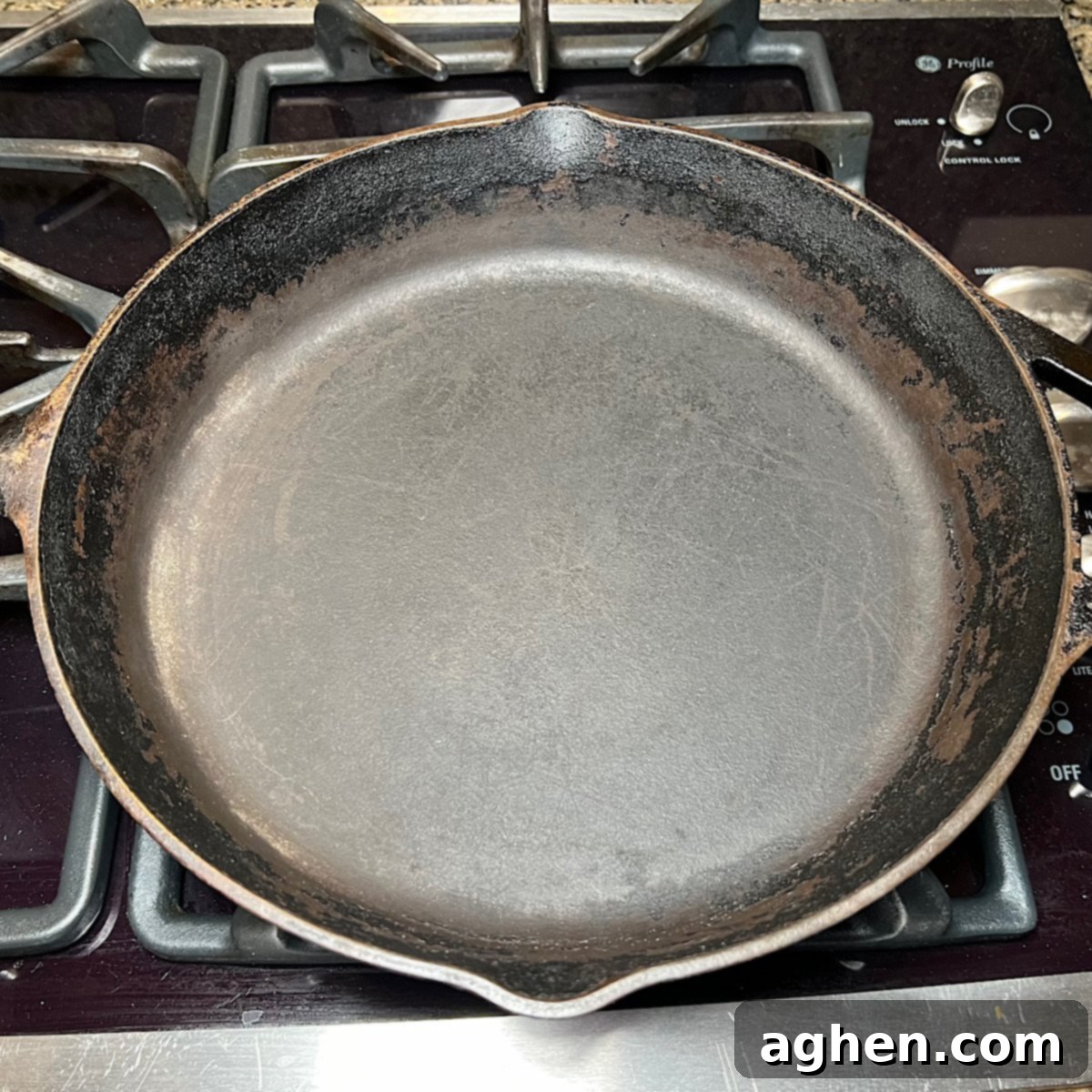
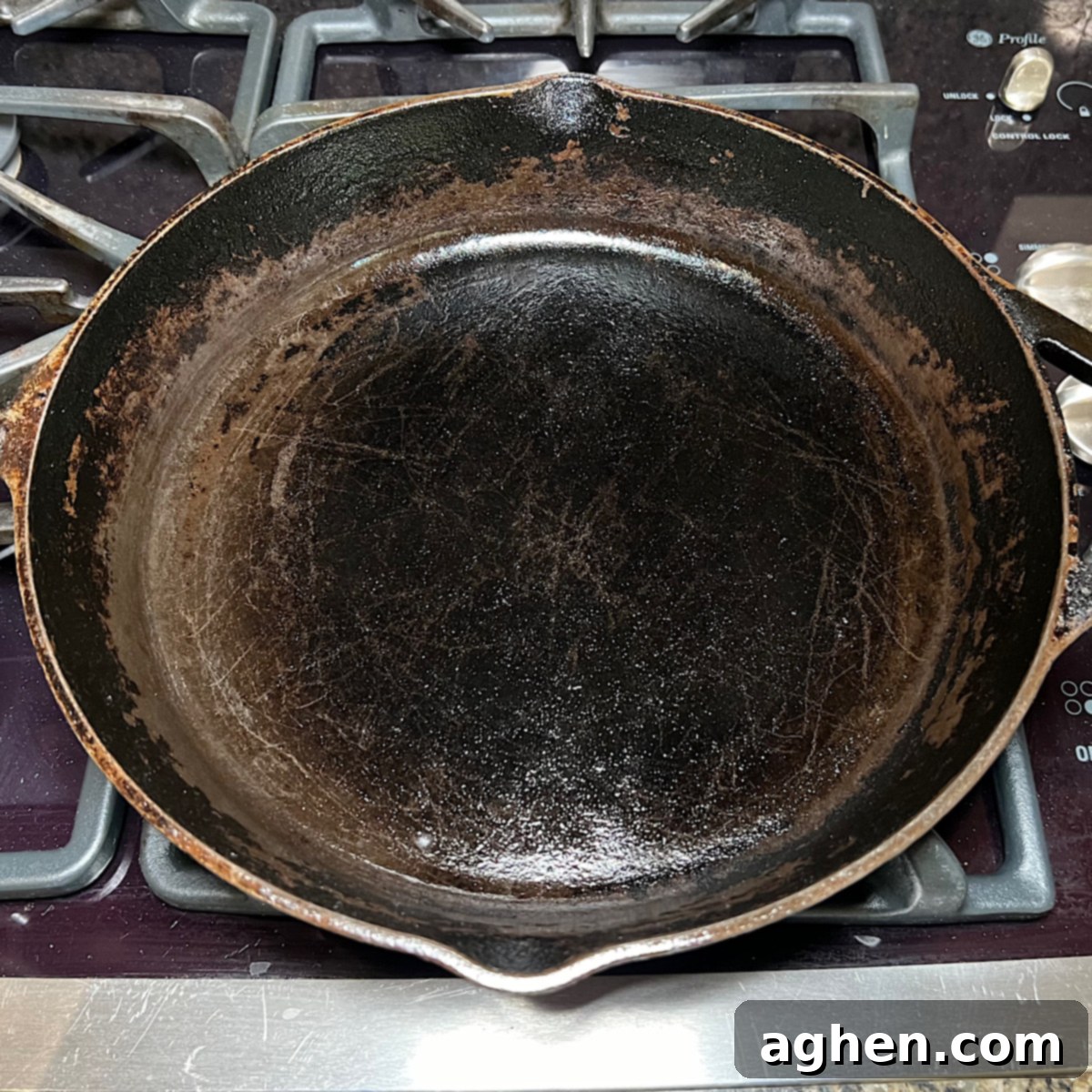
3. Gradually Heat the Skillet: Place your prepared cast iron skillet on a stovetop burner and set the heat to low. Allow the skillet to heat slowly and evenly for about 10-15 minutes. Cast iron retains heat exceptionally well, but it also takes time to heat up uniformly. Gradually increasing the temperature ensures that the entire cooking surface is consistently hot, which is key for an even sear. You’ll know it’s ready for the next step when the handle becomes hot to the touch, indicating the pan has absorbed sufficient heat.
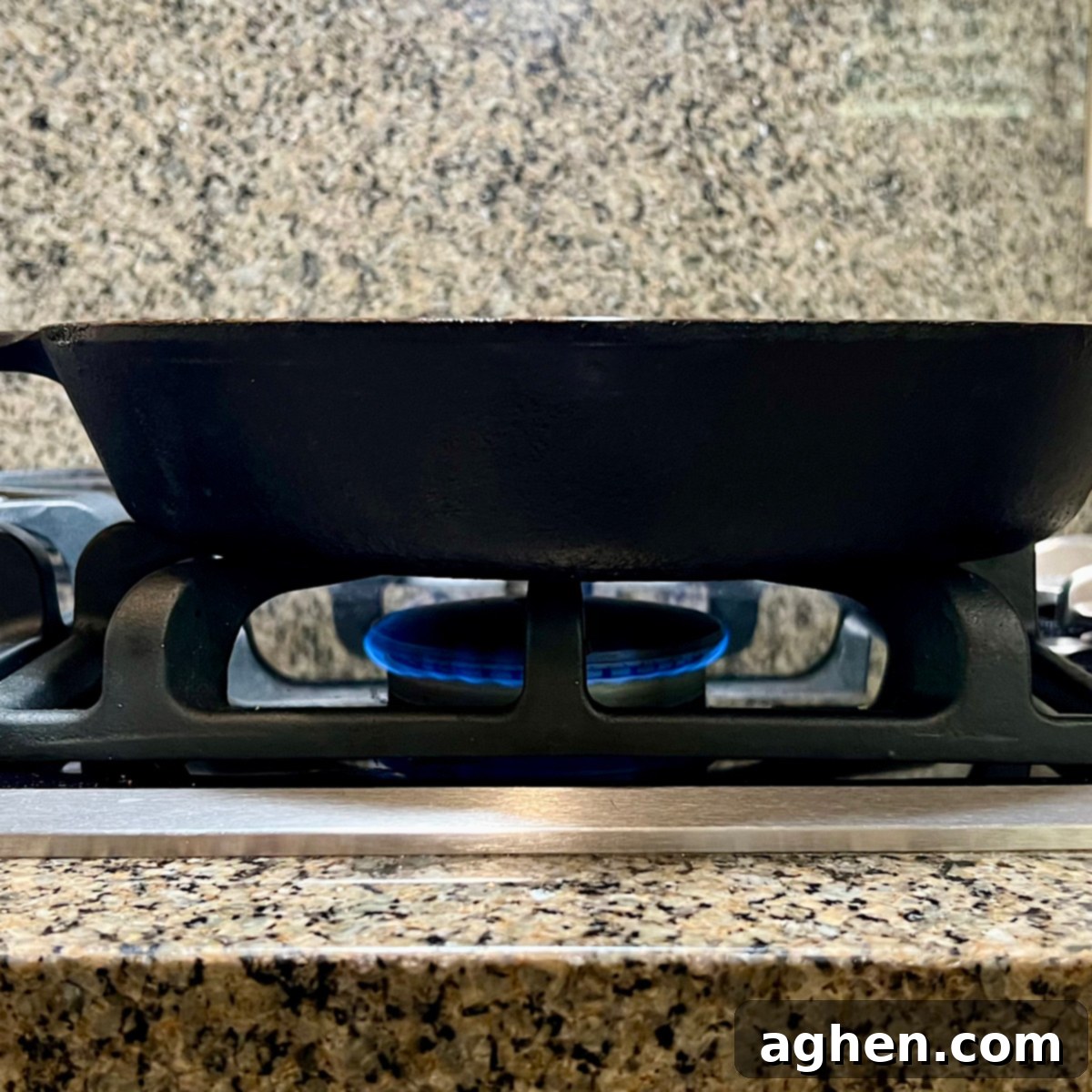
4. Increase Heat for Searing: After the initial slow heating, turn the burner up to medium-high heat. Allow the skillet to continue heating for another 2-3 minutes. At this point, if there’s any residual olive oil from the seasoning step, you’ll notice it begin to shimmer and perhaps produce a very faint wisp of smoke. This is the perfect indication that your cast iron skillet has reached the optimal searing temperature – hot enough to create an incredible crust without burning the oil or the steak prematurely.
5. Sear the Ribeye Steak: Before placing the steak, add another small drizzle of fresh olive oil directly into the hot skillet. Immediately place the seasoned ribeye steak into the smoking hot cast iron skillet. It should sizzle loudly upon contact. Cook undisturbed for exactly 2 minutes to develop that deep crust. Resistance is key here – resist the urge to move or peek at the steak. Moving it prematurely prevents the Maillard reaction from fully developing. After 2 minutes, carefully lift the steak with tongs, add another drizzle of olive oil to the now empty spot, and then flip the steak to the other side. Cook the second side for another 2 minutes, again without moving it, to achieve an equally beautiful sear.
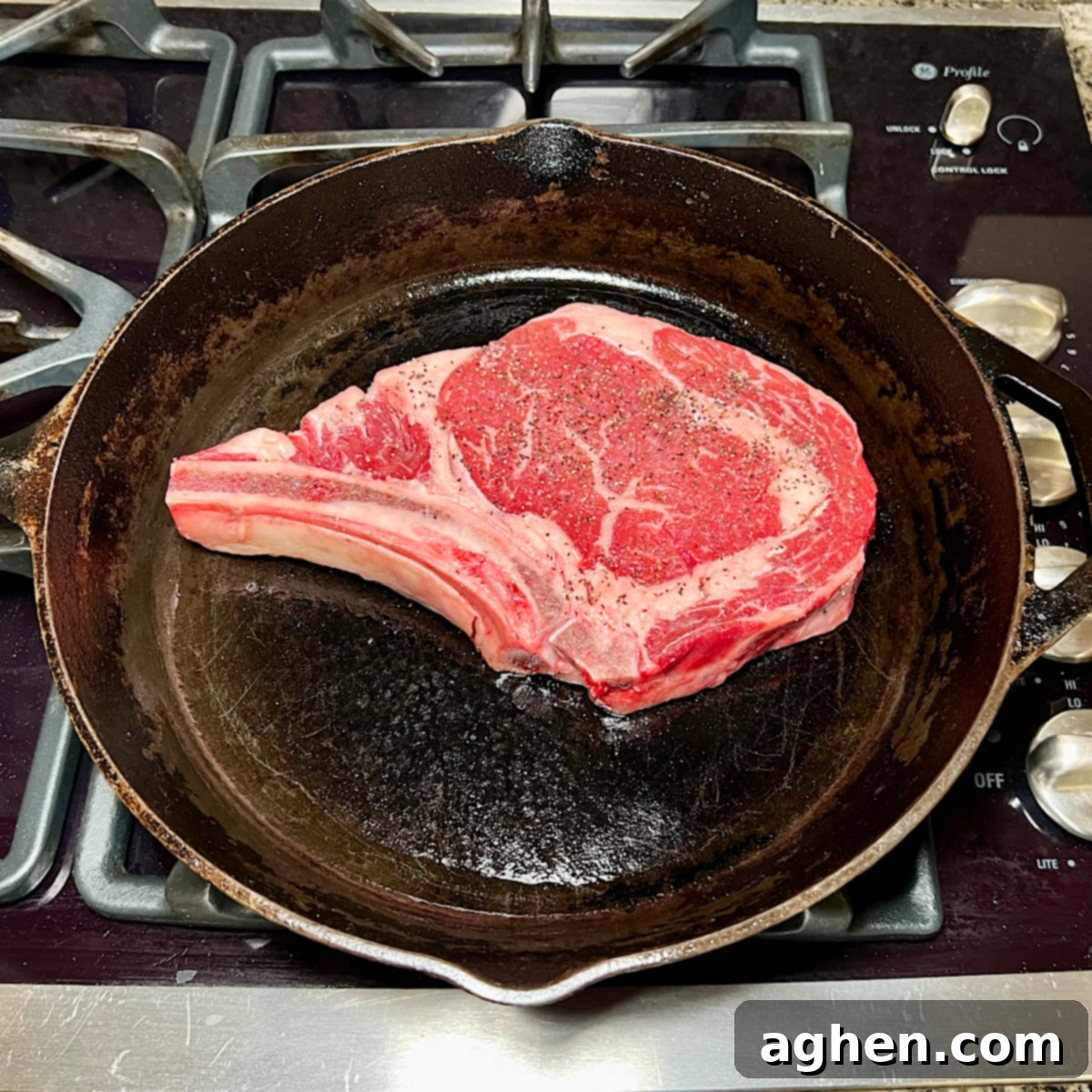
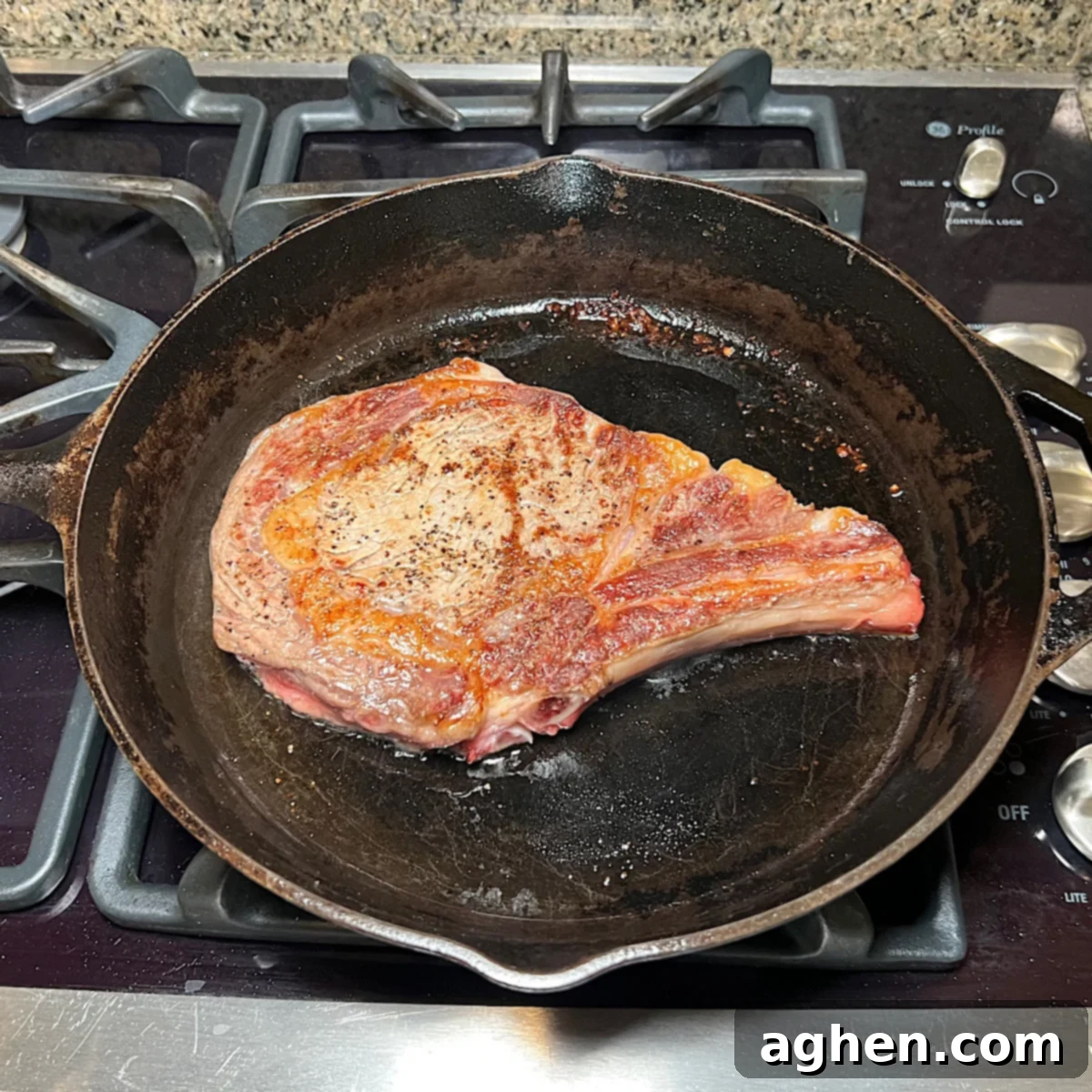
6. Infuse Flavor with Butter and Thyme: Reduce the heat to medium-low. Carefully add the room-temperature butter and fresh thyme sprigs directly into the skillet, around the steak. As the butter melts and sizzles, tilting the pan slightly, use a large spoon to continuously baste the steak with the fragrant melted butter and thyme mixture. Spoon this liquid over the steak repeatedly for about 1-2 minutes. This basting process not only infuses the steak with incredible savory flavors but also helps to cook the sides of the steak more gently. Flip the steak over once and continue basting for another 1-2 minutes on the other side. During this stage, you can also use tongs to sear the edges of the steak for about 30-60 seconds each, if they are particularly thick.
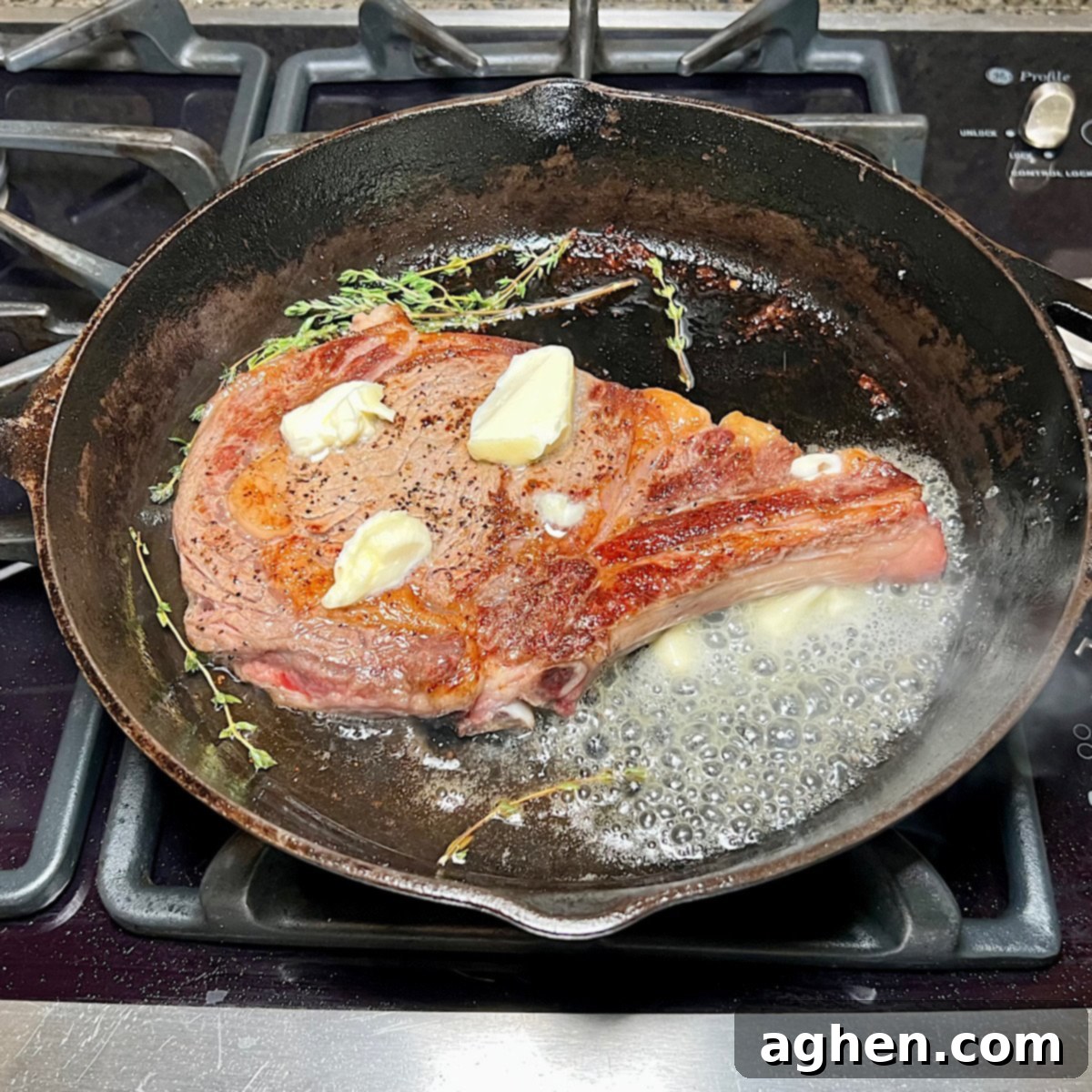
7. Check Doneness and Rest: For accurate doneness, insert an instant-read meat thermometer into the thickest part of the ribeye steak, avoiding any bone. For a medium-rare steak, aim for an internal temperature of approximately 130-135°F (54-57°C) before resting. Once your steak reaches your desired internal temperature, immediately remove it from the cast iron skillet and transfer it to a clean cutting board or plate. Tent it loosely with aluminum foil and allow it to rest for at least 5-10 minutes. Resting is absolutely essential; it allows the muscle fibers to relax and reabsorb the juices that have been pushed to the center during cooking. Skipping this step will result in a dry steak, as all the delicious juices will run out onto your plate when you cut into it. While the steak rests, you can prepare the optional mustard cream sauce.
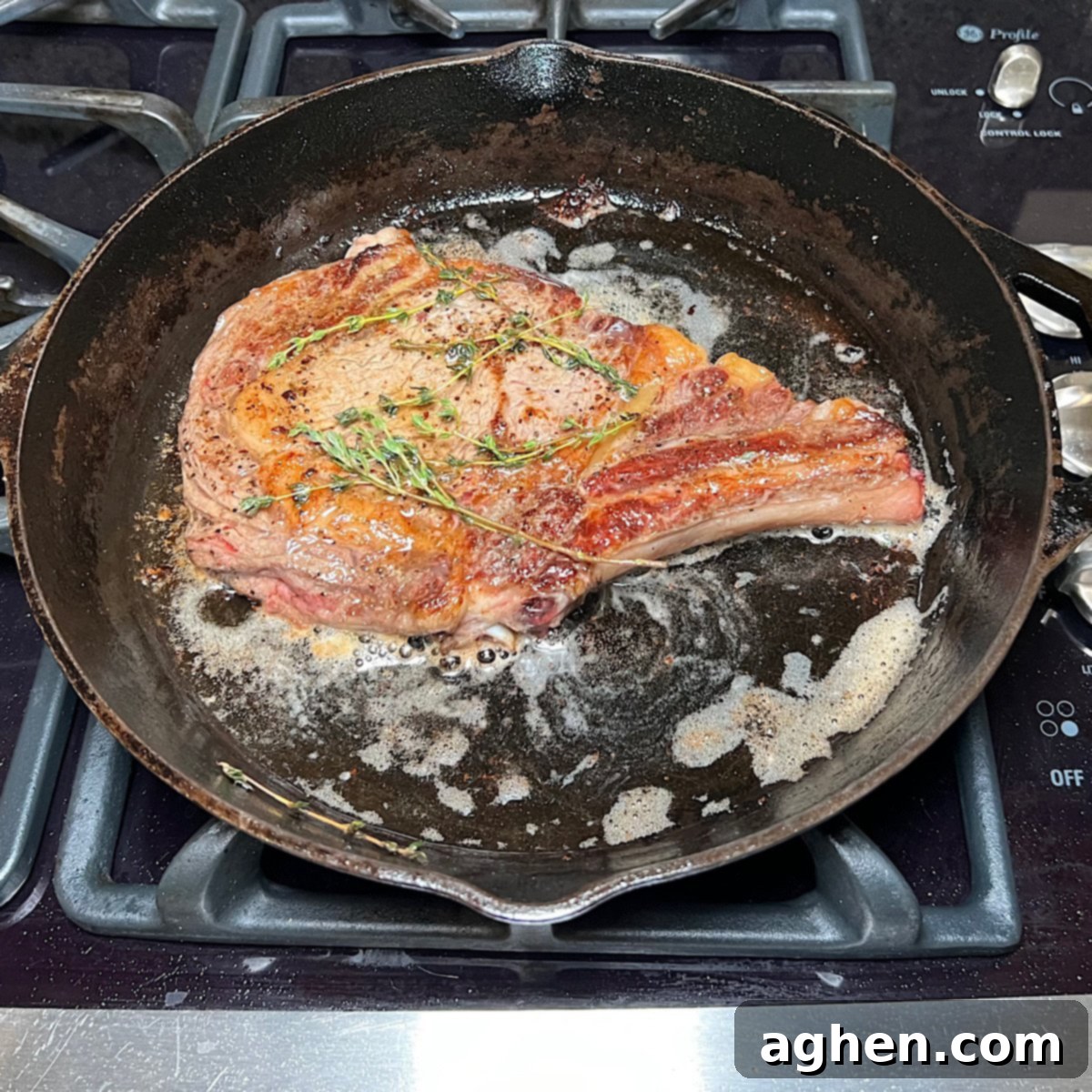
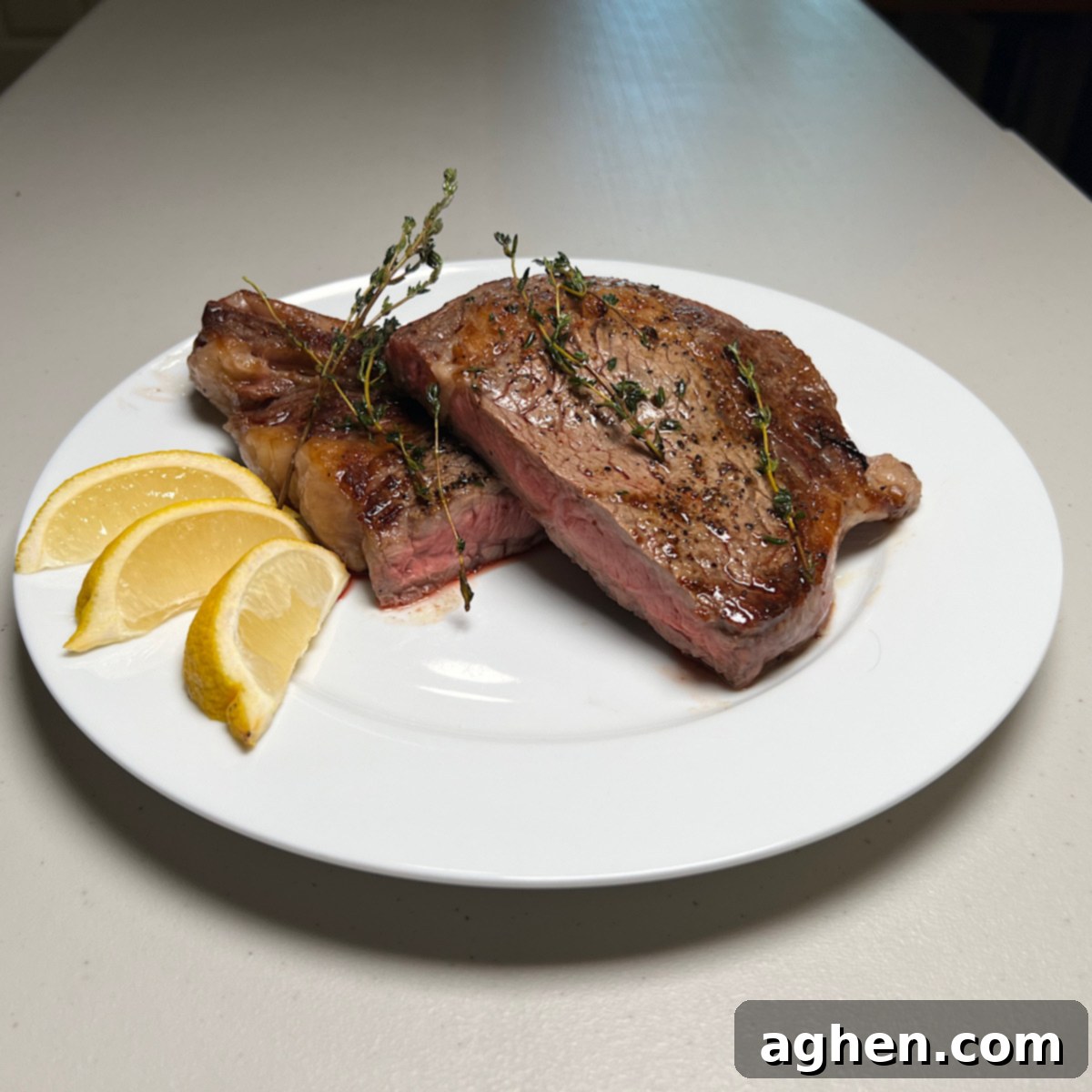
Directions For Making Mustard Cream Sauce In A Cast Iron Skillet
Add a gourmet touch to your steak with this simple, flavorful sauce:
1. Prepare Skillet for Sauce: After removing your cooked ribeye steak to rest, carefully pour off any excess grease from the cast iron skillet. You want to leave behind any flavorful bits (fond) stuck to the bottom, as these will contribute immensely to the sauce’s depth. Place the skillet under hot running water (be careful of steam!) and use a stiff brush or paper towels to quickly wipe out any burnt bits or remaining grease, leaving the caramelized fond intact. A well-seasoned cast iron skillet should clean up quite easily at this stage.
2. Cook the Mustard Cream Sauce: Return the cast iron skillet to the stovetop. Allow it to cool for about 2-3 minutes if it’s still extremely hot, then turn the burner to low heat. Add the heavy cream, Dijon mustard, and a pinch of salt and pepper to the skillet. Use a whisk to vigorously combine the ingredients, scraping up any browned bits (fond) from the bottom of the pan. These bits will dissolve into the sauce, adding incredible flavor. Continue to whisk gently and simmer the sauce over low heat for 3-5 minutes, or until it has thickened to your desired creamy consistency. Taste and adjust seasoning if necessary. Once ready, slice your rested ribeye steak against the grain, arrange it on plates, and generously spoon the warm, velvety mustard cream sauce over each serving. Serve immediately and savor every bite!
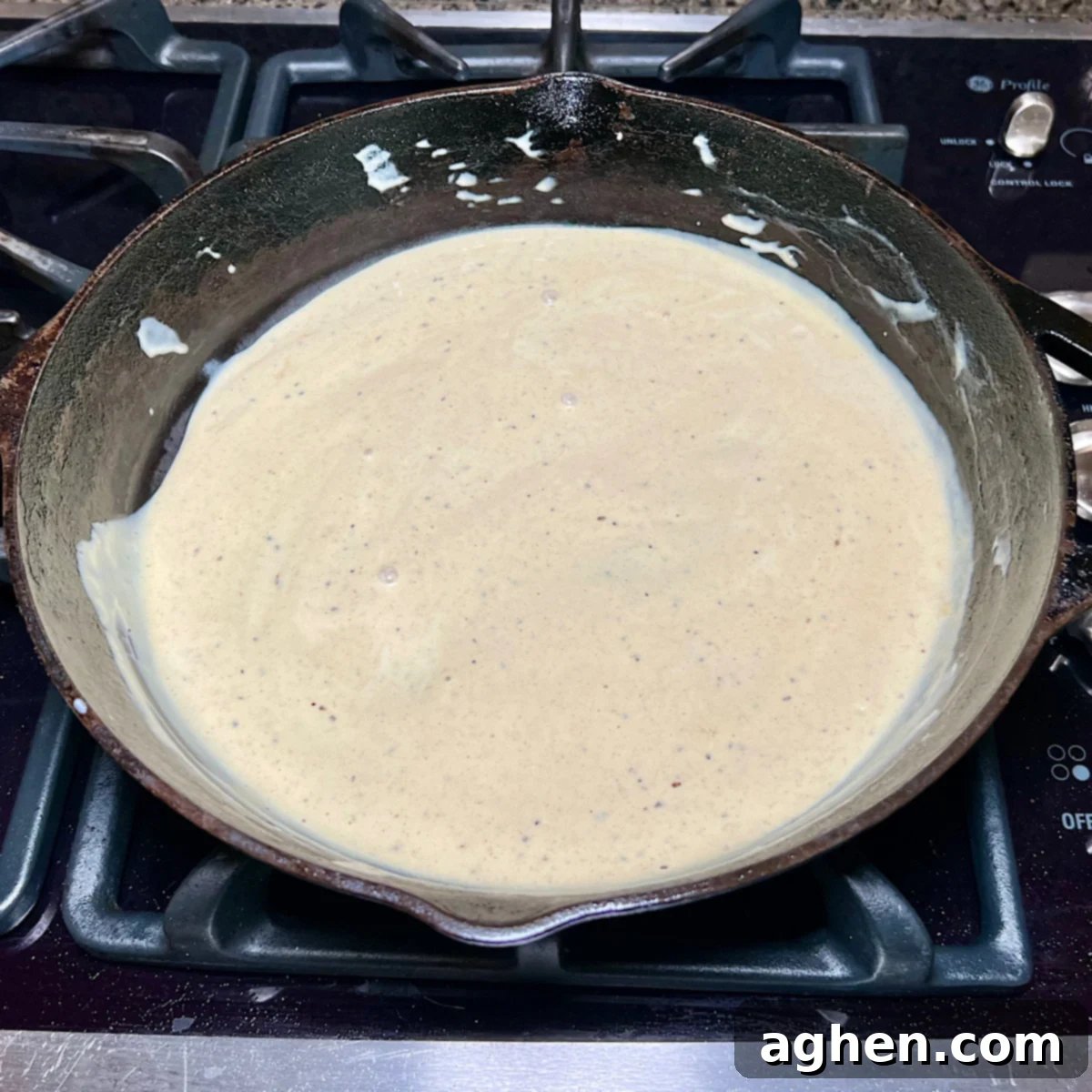
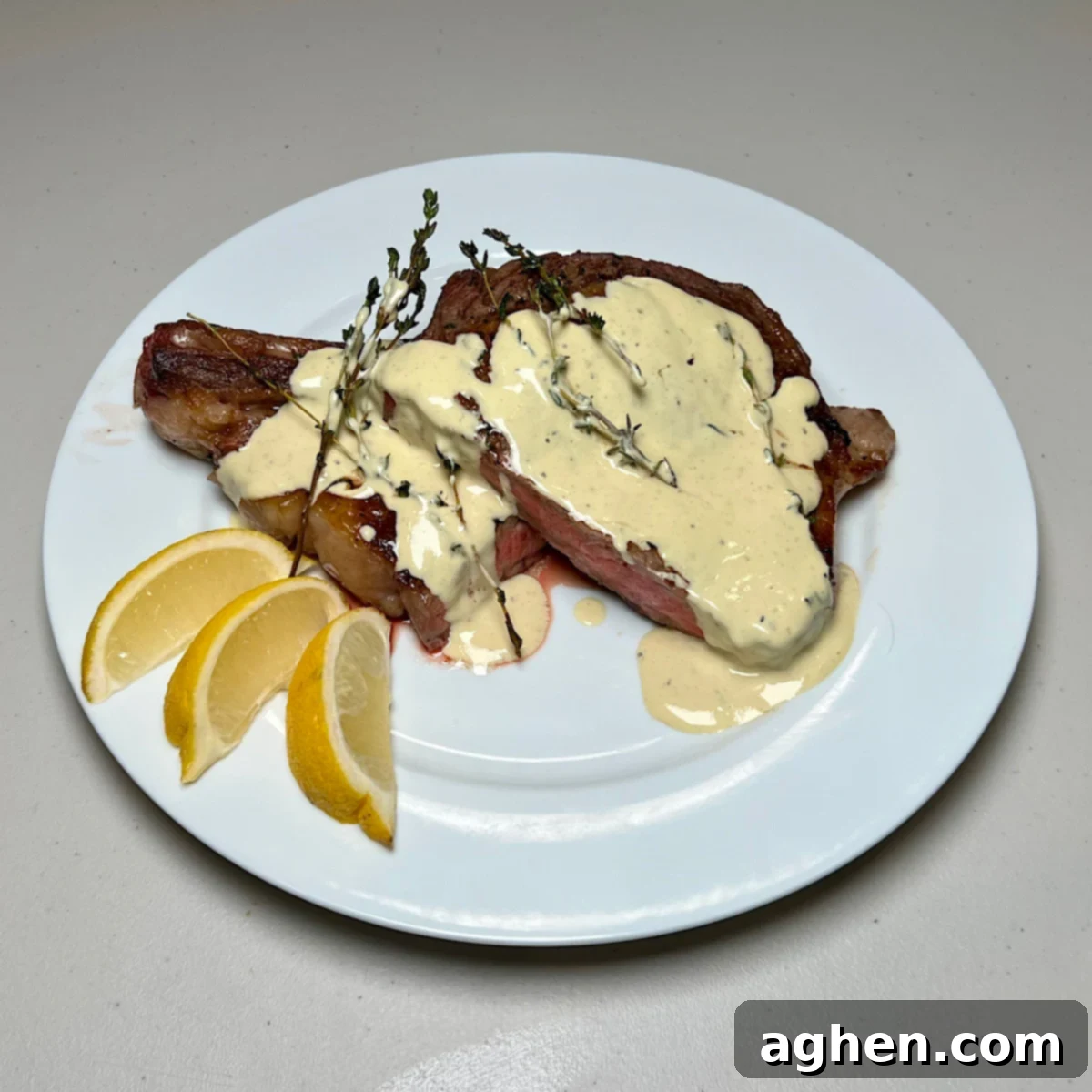
Variations and Substitutions for Your Cast Iron Ribeye Steak
Customize your steak experience with these creative alternatives:
Try Other Cuts of Steak: While the ribeye is a phenomenal choice for its marbling and flavor, the cast iron skillet method is incredibly versatile and can be applied to many other cuts of steak. Consider a thick-cut Porterhouse or T-bone for a two-in-one experience (strip and tenderloin), a majestic Tomahawk chop for an impressive presentation, or a robust New York strip steak for a firmer texture. Even a London Broil (often a top round or flank steak) can be beautifully seared, though thinner cuts will require significantly less cooking time and should be sliced against the grain for tenderness. Experimenting with different cuts will allow you to discover new favorites while perfecting your searing technique.
Experiment with Other Fresh Herbs: The aromatic pairing of fresh thyme and butter during the basting process beautifully complements the rich flavor of ribeye. However, don’t hesitate to explore other fresh herbs to customize your steak. Rosemary sprigs offer a pungent, woodsy note that pairs wonderfully with beef. Sage provides an earthy, slightly peppery flavor, while dill can add a fresh, bright accent. For a more Mediterranean twist, consider basil or oregano, or a sprinkle of fresh parsley for a clean finish. A combination of herbs, like a classic Herbes de Provence blend, can also create a complex flavor profile that elevates your steak.
Explore Different Finishing Sauces: Our mustard cream sauce offers a fantastic balance of creaminess and tang, but the beauty of a cast iron skillet meal is its adaptability. While your steak rests, the same skillet can be used to whip up an array of other delicious finishing sauces. A pungent blue cheese sauce adds a sharp, savory kick. A classic green peppercorn sauce provides a subtle spice and sophisticated flavor. For simplicity, melt a compound garlic herb butter directly in the pan. Explore a rich Steak Diane sauce with mushrooms and brandy, or a smoky butter whisky sauce for a unique depth. A simple pan sauce with sautéed mushrooms and a splash of beef broth is always a winner. Each of these sauces can be prepared quickly, leveraging the flavorful fond in the pan, and will turn your cast iron ribeye into a truly unique culinary creation.
Expert Tips and Tricks for a Flawless Cast Iron Ribeye Steak
Elevate your steak game with these essential insights and techniques:
Monitor the Temperature of Your Cast Iron Skillet: Understanding the thermal properties of cast iron is crucial for success. Cast iron skillets heat up slowly and retain heat incredibly well, meaning they also cool down gradually. This characteristic is what allows for that superior sear, but it also requires attention to temperature management. Always preheat your skillet slowly and thoroughly to ensure even heat distribution. If the skillet gets too hot, remove it from the heat for a minute or two to allow it to cool slightly before continuing. Likewise, if it cools down too much, briefly increase the heat. Our timing recommendations are for a medium-rare finish, so adjust the searing time by 30-60 seconds per side for a rarer or more well-done steak, always relying on an internal temperature check for precision.
Cook the Edges of a Thick Ribeye Steak: Thick-cut ribeye steaks often have a substantial fat cap or thick edges that won’t make full contact with the pan during standard searing. To ensure these parts render and cook properly, use a pair of sturdy tongs to hold the steak on its side, pressing the edges directly against the hot cast iron for about 30-60 seconds per edge. This renders the fat, adding more flavor to the pan and creating a beautifully caramelized crust all around the steak, preventing any uncooked, rubbery sections.
How to Tell When Your Ribeye Steak is Done: The most accurate and reliable way to determine your steak’s doneness is with an instant-read meat thermometer. Insert the thermometer into the thickest part of the steak, away from any bone, and let it register for a few seconds. The thermometer should slide in smoothly. Here’s a quick guide for desired doneness after resting:
- Rare: 120-125°F (49-52°C) – Cool red center.
- Medium-Rare: 130-135°F (54-57°C) – Warm red center. This is often recommended for ribeye.
- Medium: 140-145°F (60-63°C) – Warm pink center.
- Medium-Well: 150-155°F (66-68°C) – Slightly pink center.
- Well-Done: 160°F+ (71°C+) – Little to no pink.
While a thermometer is best, with practice, you can also learn the “touch test” method. Gently press on your steak with your finger or tongs. A rare steak will feel very soft and yielding, similar to the fleshy part of your palm below your thumb when your hand is relaxed. As it cooks to medium-rare, it will firm up slightly (like pressing your thumb to your forefinger), and a medium steak will be noticeably firmer. A well-done steak will feel quite firm with very little give (like pressing your thumb to your pinky finger). Combining both methods will make you a steak-cooking pro!
Avoid Overcrowding the Pan: If you’re cooking more than one steak, avoid overcrowding the skillet. Too many steaks will lower the pan’s temperature dramatically, causing the meat to steam rather than sear, leading to a grey, unappetizing crust. Cook steaks in batches if necessary, ensuring proper spacing for optimal searing.
Choose the Right Oil: For high-heat searing, select an oil with a high smoke point. Olive oil works well, but grapeseed, avocado, or even clarified butter (ghee) are excellent choices as they can withstand higher temperatures without burning, which can impart off-flavors to your steak. Regular butter has a lower smoke point and is best added during the basting phase.
Ensure Good Ventilation: Cooking steak in a cast iron skillet, especially at high temperatures, will produce a fair amount of smoke. Make sure your kitchen is well-ventilated. Turn on your range hood to its highest setting, and if possible, open a window to allow the smoke to dissipate quickly. This will keep your smoke detectors happy and your kitchen fresh.
Season Your Skillet Regularly: A well-seasoned cast iron skillet is key to achieving a perfect non-stick surface and an incredible sear. After each use, clean your skillet thoroughly with hot water (avoid harsh soaps), dry it completely, and apply a very thin layer of cooking oil. Heat it gently on the stovetop for a few minutes until it just begins to smoke, then let it cool. This simple maintenance ritual builds up the seasoning over time, making your skillet even better with every use.
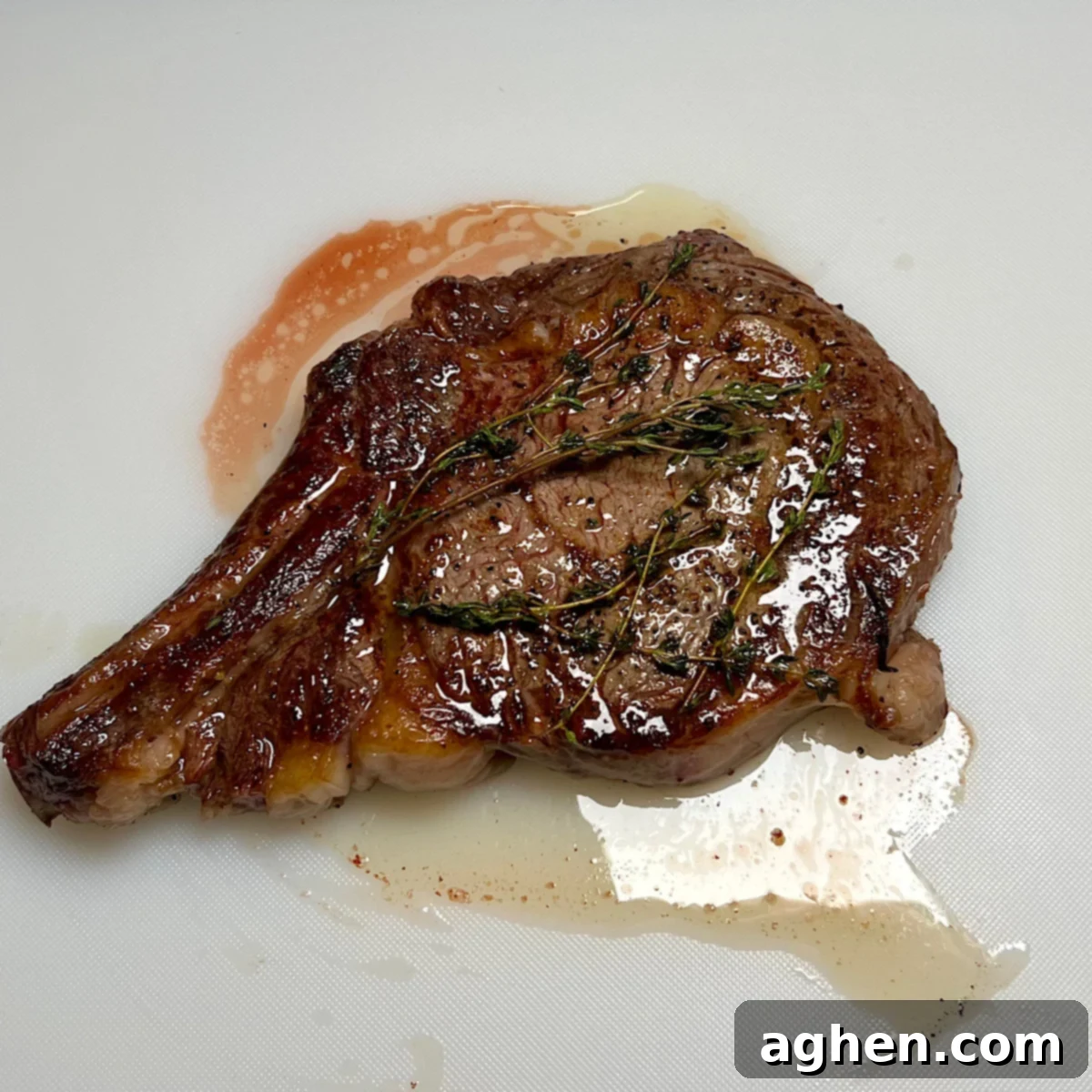
Cast Iron Skillet Rib Eye
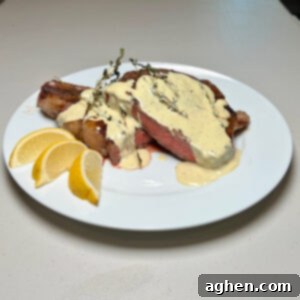
Equipment
-
1 Cast Iron Skillet pre-seasoned
-
1 Tongs for flipping
-
1 Tablespoon for basting
Ingredients
Ingredients For Rib Eye Steak In A Cast Iron Skillet
- 1 ½-2 lbs one rib eye steak roughly, 1 ½ inches thick
- 1 teaspoon salt and pepper, ½ teaspoon each
- 1/4 cup olive oil for the cast iron skillet and drizzling
- 6 sprigs fresh thyme
- 3 tablespoons room temperature butter
Ingredients For Mustard Cream Sauce In A Cast Iron Skillet
- ¾ cup heavy cream
- 3 tablespoons Dijon mustard
- 1 pinch of salt and pepper
Instructions
Directions For Rib Eye Steak In A Cast Iron Skillet
-
Bring the rib eye steak to room temperature – Let the rib eye steak rest on a plate for 15 minutes. Then, wipe off the moisture and liberally apply the salt and pepper to both sides.
-
Rinse and oil the cast iron skillet – Rinse the skillet with warm water and wipe out with paper towels. Pour one tablespoon of olive oil into the skillet, and with a paper towel, thoroughly coat the entire inside surface of the skillet with the olive oil.
-
Slowly heat up the cast iron skillet – Place your skillet on a stovetop burner set to low for 15 minutes. When the handle is hot to the touch, the skillet is ready to cook with.
-
Turn the burner up to medium-high – Turn the burner up to medium-high for 2 minutes until the olive oil starts to shimmer and smoke slightly.
-
Place the rib eye steak in the cast iron skillet – Drizzle a little more olive oil onto the cast iron skillet, place the rib eye steak in the skillet, and cook for 2 minutes. Lift the rib eye steak up and add another drizzle of olive oil, then flip and cook for another two minutes. Very important: do not move the steak around after it hits the pan! This is what creates a nice sear.
-
Add the butter and thyme to the pan and rib eye steak – With a butter knife, add the butter to the top of the steak and the cast iron skillet. As the butter melts, using a tablespoon, baste the steak with the butter 4 or 5 times. Flip the steak over, and baste with the butter again. A meat thermometer inserted in the thickest part of the rib eye steak should read roughly 130 degrees for a medium rare steak.
-
Remove the now cooked rib eye steak, place it on a plate, and let it rest for 5-10 minutes.
Directions For Making Mustard Cream Sauce In A Cast Iron Skillet
-
Clean out your cast iron skillet – At the kitchen sink, pour off the grease left in the cast iron skillet and run hot water into the cast iron skillet. Wipe out the cast iron skillet with paper towels, leaving any fond.
-
Return the cast iron skillet to the stove top – Place the cast iron skillet back on the stovetop and let it cool down for 3 minutes. Turn the burner on low and add the heavy cream, mustard, salt, and pepper. Whisk the ingredients together and cook until the sauce is thick and creamy. Pour on top of your fabulous cast iron skillet rib eye and enjoy!
Nutrition
Nutrition information is automatically calculated, so should only be used as an approximation.
